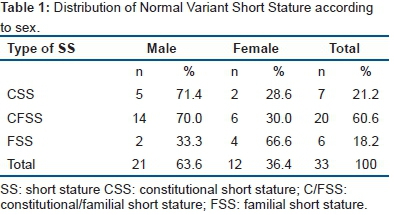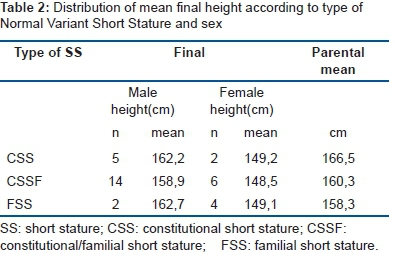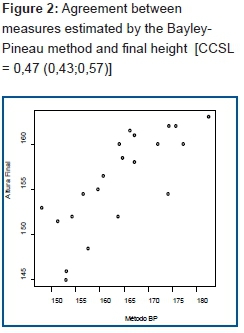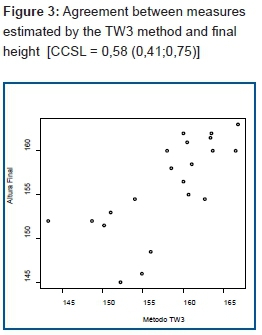Serviços Personalizados
Journal
artigo
Indicadores
Compartilhar
Journal of Human Growth and Development
versão impressa ISSN 0104-1282versão On-line ISSN 2175-3598
J. Hum. Growth Dev. vol.27 no.3 São Paulo set./dec. 2017
https://doi.org/10.7322/jhgd.131259
ORIGINAL ARTICLE
Comparison of methods for final height assessment in adolescents with a normal variant short stature
Karla Cristina Malta Costa; Inez Tomita; Marco Antonio Barbieri; Heloisa Bettiol; Luiz Antonio Del Ciampo
Department of Puericulture and Pediatrics, Faculty of Medicine of Ribeirão Preto, University of São Paulo
ABSTRACT
INTRODUCTION: Patients with low stature normal variant growth have peculiar evolutionary patterns making it difficult to precisely define when final stature will be reached, since prediction methods are based on parameters of difficult quantification, such as bone age.
OBJECTIVE: To assess the agreement between two methods for prediction of final height based on family target range regarding the final height reached by adolescents with a diagnosis of normal variant short stature.
METHODS: Thirty-three subjects were evaluated using height of parents for the calculation of family target range and Bayley-Pinneau and Tanner-Whitehouse methods for prediction of final height. Spearman correlation coefficient was calculated to correlate final height with the mean of the family target range, and the St. Laurent concordance coefficient was used to assess concordance between final stature and predictive methods.
RESULTS: 87.9% (29/33) subjects kept short stature at the end of growth and 90.9% (30/33) had a final height within family target range. A very strong positive correlation (Cs = 0.77; p < 0.01) was observed between parental mean and final height. Bayley-Pinneau method showed a 0.47 concordance coefficient with final height (95% CI: 0.34; 0.57), and Tanner-Whitehouse 3 method showed a concordance coefficient of 0.58 (95% CI: 0.41; 0.75.
CONCLUSION: The strong positive correlation observed demonstrates the significant influence of parental height on final height. Neither method showed good concordance when used as a predictor of final height, with height values being overestimated.
Keywords: short stature, final height, bone age.
INTRODUCTION
Short stature in children is a condition that causes considerable worry on the part of the parents and pediatricians1,2, although in most cases it represents normal variant situations that are only the normal extreme distribution of height, without the presence of diseases3. One of the assessments most frequently used in pediatric care, which can rapidly advise and reassure parents about child growth, is the definition of the family target range, which permits to determine whether a child is within the normal limits of expected height estimated from the height of the parents4.
Various terms are used in pediatric practice to classify normal variants of short stature5-7 such as normal variant short stature, constitutional short stature, familial short stature, constitutional growth delay, slow familial maturation, and idiopathic short stature8.
The expectations of the parents, the patients and the professionals who monitor these children regarding final height have led to the necessity to formulate estimation methods such as calculation of family standard and formulas for the prediction of final height. Final height is influenced by genetic, endocrinologic, nutritional, environmental and social parameters9. The prediction of final height is currently considered to be the most important parameter for the decision of whether some treatment should or should not be instituted, even among children with no evidence of disease10.
Some factors that influence growth, especially the rate of maturation, show peculiar evolving patterns that interfere with the accuracy of the prediction of final height11,12. For a more accurate prediction of final height it is necessary to assess bone age associated with chronological age and with current height. One of the criteria used to consider that an individual has reached his final height is an annual increase in height of less than one centimeter after the pubertal spurt13. However, it is difficult to define exactly the final height that will be reached since, in general, the methods for the assessment of final height are faulty, are based on imprecise parameters12 and therefore cause this prediction to be criticized.
The objective of the present study was to assess the agreement between two methods for the prediction of final height and of height based on the family target range with the final height reached (gold standard) in adolescents with a diagnosis of normal variant short stature seen at an outpatient clinic for the evaluation of growth problems.
METHODS
A descriptive, longitudinal and retrospective study was conducted using selected data of medical records of all patients seen at the Outpatient Clinic for Growth and Development Problems of the University Hospital, Faculty of Medicine of Ribeirão Preto-USP (APCD-HCFMRP-USP) between 1987 and 2009. The inclusion criteria were: diagnosis of normal variant short stature, absence of associated organic disease, presented information that allowed the calculation of the family channel, radiological examination for evaluation of bone ageand attainment of final height, i.e., an annual increase in height of less than one centimeter after the pubertal spurt. Patients whose medical records did not provide all the information necessary for the study were excluded.
Children were considered to have normal variants of short stature when they did not show symptoms of current or previous chronic diseases, with height below the third percentile (P3) of the growth curve for age and with a normal growth rate3. The subjects were divided into three groups according to the genetic factors that determine short stature: 1) familial short stature when the stature is appropriate for the family target range or genetic potential and there is no delayed bone age, and when the child is short because his/her parents are short; 2) constitutional short stature when bone age is delayed - < 2 mean standard deviations (SD) - and height is below the family target range, the onset of puberty is delayed, the growth spurt is delayed and consequently the children continue to grow when their peers are no longer growing; 3) constitutional short stature with a familial component, with height following the family target range, with bone age being delayed at least during the prepubertal period, with pubertal delay being present or not, and with final height ending within the family range3,6,13.
Anthropometric assessment was performed by trained personnel using a 200-cm long vertical anthropometer with 0.5 cm approximation. The parental mean and the family target range according to the child's sex were calculated based on the height of the parents6. Pubertal stage was assessed according to the criteria of Marshall & Tanner14. Bone age was assessed before the onset of puberty by the methods of Greulich Pyle (GP) and Tanner Withehouse (TW)3, which consider the standard deviation (SD) and sex to define it as delayed (< 2 SD), accelerated (> 2SD) or compatible with chronological age.
Two methods for the prediction of final height were used: 1) the Bayley-Pinneau method, which calculates height based on patient stature (at the time when left hand and wrist radiography was obtained) divided by the growth fraction determined according to bone age obtained by the GP method15; 2) the TW-3 method which uses chronological age, height and bone age RUS-score. The calculation was performed using specific software (RUS Child Height Prediction Utility) with application of the following formula: final height = current height + a x RUS-score + b (where a and b are constants that vary according to the chronological age of the patient)16. The predictions were carried out before puberty due to the fact that bone age acceleration is greater than that of chronological age during puberty, reaching a peak of up to 1.5 year/year at an age close to the spurt17.
The Spearman correlation coefficient (Cs) was used to correlate final height reached with the parental mean value of the family target range, and the St. Laurent concordance coefficient (CCSL) was used to determine the concordance of final height reached (considered to be the gold standard) and the height values obtained by methods for the prediction of final height. The coefficients and their 95% confidence intervals were calculated by the bootstrap method with the aid of the SAS 9.1 software. The study was approved by the Research Ethics Committee of HCFMRP-USP, nº 6827/2009.
RESULTS
Thirty-three patients out of 351 patients with short stature followed in our Outpatient Clinic were selected for the study since they presented an annual increase of stature inferior to a one centimeter after the puberal spurt registered in the medical record and with enough information for the calculation of the familiar channel. Table 1 presents the distribution of these patients according to the diagnosis of Normal Variant Short Stature, age and sex.

When they reached their final height, 30 patients (90.9%) had a final height within the family target range and 29 (87.9%) continued to have a diagnosis of short stature. Table 2 shows the mean final height reached by the patients according to type of short stature and sex.

The Spearman correlation coefficient (Cs) between final height and mean parental height was calculated separately for the groups with normal variant short stature among the 33 patient. The result for the group as a whole was 0.77 (p-value < 0.01), demonstrating a very strong positive correlation between variables. The correlation between the groups with short stature was also calculated, with the following results: in the group with constitutional/familial short stature there was a very strong positive correlation between the parental mean and the final height, with Cs 0.82 (p < 0.01); in the group with constitutional short stature the correlation was moderate, with Cs 0.45 (p = 0.31); in the group with familial short stature (FSS) the correlation was strong (Cs = 0.89; p = 0.03) despite the small number of subjects with this diagnosis.
The Bayley-Pinneau method showed CCSL of 0.47 (95% CI: 0.34 - 0.57) with final height reached, while the TW3 method showed CCSL of 0.58 (95% CI: 0.41 - 0.75). With both methods, the predicted final height was higher than the true final height for the patients under study (Figure 1). The predicted height measures were found to have been overestimated when the height reached after somatic growth was assessed, a fact particularly observed with the Bayley-Pinneau method (Figures 2 and 3). The mean difference between height reached and predicted height for the three types of short stature was 8.02 cm (range: - 5 to + 19.6 cm) with the use of the Bayley-Pinneau method and 1.95 cm (range: - 8.8 to + 8.9 cm) with the use of the TW3 method. It should be pointed out that the difference between predicted height and final height was calculated for each subject



DISCUSSION
The present study showed that most of the patients ended their growth with short stature and within the family target range. The correlation between final height reached and mean parental height was high for all three types of normal variant short stature, mainly for the variants with a familial component of short stature. In contrast, the correlation between final height reached and final height estimated by the methods for evaluation was moderate, with estimated final height being higher than the final height actually reached.
Considering that 81.5% of the patients seen at APCD-HCFMRPUSP had a diagnosis of short stature and that 53% of them were normal variants, it is clear that a child with short stature should be fully evaluated by means of careful anamnesis, accurate physical examination with the measurement of growth rate and with appropriate diagnostic investigation so that therapeutic proposals can be defined or an expectant attitude may be established when an underlying disease is excluded.
The higher frequency of constitutional/familial short stature (54.4%), followed by familial short stature (25.3%) reflects the importance of family inheritance regarding short stature18,19. Males corresponded to almost two thirds of the cases, a fact explained by the greater concern about growth among men, in addition to the psychological impact of growth pattern possibly affecting boys when compared to their peers19,20.
Among the 351 patients with short stature diagnosed, we only studied a sample of 33 subjects (9.4%) because some patients had no indication for treatment since they had a normal variant and, after starting pubertal growth and reaching a satisfactory height, they preferred to stop follow-up.
It can be seen that the groups with a familial component, constitutional/familial short stature and familial short stature, showed a very strong positive correlation between final height reached and the mean value for the family target range. The diagnosis of short stature at the end of growth demonstrates that parental height has a significant effect on this outcome, confirming the similarity of these groups regarding familial inheritance of growth8,19,21-23.
The two methods of assessment of final height, Bayley-Pinneau and TW3, did not show good agreement when used to predict final height. In addition, they yielded final height estimates higher than real height. Other studies which assessed methods for the prediction of final height also yielded greater than real measures of final height used, especially considering the Bayley-Pinneau method23,24. Among thalassemic patients, the comparison of GP and TW3 for the determination of skeletal maturity and the prediction of final height showed that both methods tended to overestimate final height. The cited study also showed that the same method should be used in serial patient assessments since the two methods have similar reliability but their results are not equivalent25. Crowne et al.20 assessed final height in boys with constitutional growth delay and observed that there was no significant difference between final height and predicted adult height using the TW2, although they detected a significant difference between final height and the parental mean20. In Europe, Milner et al. in a study of 100 English children comparing the GP and TW2 methods, concluded that the methods showed a linear correlation among boys, but not among girls26. Bueno et al observed that the Bayley-Pinneau, TW2 and Roche-Wainer-Thissen methods overestimated final height among Spanish children with constitutional short stature, with the Bayley-Pinneau method being the most reliable for girls24. On the other hand, Ostojic reported considerable concordance between height estimated by the TW method and final height in young male Caucasian athletes; this strong correlation was attributed in part to the similarity of the study sample to the reference population for bone age27.
If, on the one hand, the small sample of the present study can be considered a weak point, on the other hand, the study supports the need for a complete evaluation and follow-up of children with short stature, especially regarding the prediction of adult height since the diagnostic and therapeutic management of patients with short stature and delayed puberty is controversial. Based on the present results and on literature evidence, we should emphasize the fundamental role of health professionals when monitoring normal variant short stature children considering that parental expectations regarding the potential height of their children and the anxiety of the patients themselves when facing the discrepancy in height compared to their peers are part of the growth problems seen in puericulture and general pediatric outpatient clinics. Thus, the management of these patients should be considered with caution since there are no studies with reliable methods for the prediction of final height to be used as the basis of the prescription of drugs that might raise false expectations of improved final height. As can be demonstrated in this study the BP and TW2 methods, when applied to children with a short stature diagnosis, were not adequate for final height prediction and should therefore be adopted with caution in situations whose diagnostic definition may imply clinical interventions.
Brämswig et al.28 alerted to the importance of observing the tendency of each method to over- or underestimate final height and to the wide individual variations of the estimates, especially considering if the patients receive or not treatment for the promotion of growth28.
The main limitation of this study concerns the small number of subjects evaluated because as the conduct in these cases does not require treatment, some patients end up abandoning the follow up after beginning pubertal growth and reaching a satisfactory height.
CONCLUSION
In view of the questions raised and of the findings obtained in the present study, it can be seen that the methods for the prediction of final height are limited for children with normal variant short stature. This leads to a reevaluation and reconsideration of the methods used for this purpose and of the real indication of intervention (like drugs and hormones) in these children in order to improve their final height since most of these children remains within their family target range.
REFERENCES
1. Romani SAM, Lira PIC. Determinant factors of infant growth. Rev Bras Saúde Matern Infant. 2004;4(1):15-23. DOI: http://dx.doi.org/10.1590/S1519-38292004000100002 [ Links ]
2. Weedon MN, Lettre G, Freathy RM, Lindgren CM, Woight BF, Perry JR, et al. A common variant of HMGA2 is associated with adult and childhood height in the general population. Nat Genet. 2007;39(1):1245-50. DOI: http://dx.doi.org/10.1038/ng2121 [ Links ]
3. Barbieri MA, Bettiol H, Almeida LEA, Del Ciampo LA, Tomita I. Growth and nutritional status assessment. In: Dutra-de-Oliveira JE, Marchini JS. Nutritional Sciences. São Paulo: Sarvier, 2008. p.663-90. [ Links ]
4. Tanner JM. Use and abuse of growth standards. In: Falkner F, Tanner JM. Human growth: a comprehensive treatise. New York: Plenumm Press; 1986. [ Links ]
5. Cowell CT. Short stature. In: Brook CGD. Clinical paediatric endocrinology. Oxford: Blackwell Science; 1995. p.137-72. [ Links ]
6. Fox LA, Zeller WP. Evaluation of short stature. Comprehensive Ther. 1995; 21(3):115-21. [ Links ]
7. Reekers-Mombarg LTM, Cole TJ, Massa GG, Wit JM. Longitudinal analysis of growth in children with idiopathic short stature. Ann Hum Biol. 1997;24(6): 569-83. DOI: http://dx.doi.org/10.1080/03014469700005332 [ Links ]
8. Ranke MB. Towards a consensus on the definition of idiopathic short stature. Horm Res. 1996;45(Suppl.2):64-6. DOI: http://dx.doi.org/10.1159/000184851 [ Links ]
9. Hermanussen M, Abmann C, Groth D, Staub K. Final height, target and the community. Georgian Med News. 2014;(230):30-4. [ Links ]
10. Rios R, Bosch V, Santonja F, López JM, Garaulet M. The height target prediction by the Tanner method infra evaluates the final height in youths from the rural area of South East Spain. Nutr Hosp. 2014; 31(1):436-42. DOI: http://dx.doi.org/10.3305/nh.2015.31.1.7545 [ Links ]
11. Longui CA. Previsão da estatura final - acertando no ''alvo''? Arq Bras Endocrinol Metab 2003;47(6): 636-7. DOI: http://dx.doi.org/10.1590/S0004-27302003000600002 [ Links ]
12. Setian N, Kuperman H, Della Manna T, Daminai D, Dichtchekenian V. Critical analysis of final height prediction. Arq Bras Endocrinol Metab 2003;47(6):695-700. DOI: http://dx.doi.org/10.1590/S0004-27302003000600011 [ Links ]
13. Tanner JM. Fetus into Man: physical growth from conception to maturity. Revised edition. Warvard University Press, 1990. [ Links ]
14. Marshal WA, Tanner JM. Variations in the patterns of pubertal changes in boys. Arch Dis Child. 1970;459239):13-23. [ Links ]
15. Bayley N, Pinneau SR. Tables for predicting adult height from skeletal age: revised for use with Greulich-Pyle hand standards. J Pediatr. 1952; 40(4):423-41.DOI: https://dx.doi.org/10.1016/S0022-3476(52)80205-7 [ Links ]
16. Tanner JM. Assessment of skeletal maturity and prediction of adult height (TW3 method). 3. ed. London: Saunders, 2001. [ Links ]
17. Buckler JM. Skeletal age changes in puberty. Arch Dis Child. 1984;59(2): 115-9. DOI: http://dx.doi.org/10.1136/adc.59.2.115 [ Links ]
18. Simm PJ, Werther GA. Child and adolescent growth disorders - an overview. Aust Fam Physician. 2005;34(9):731-6. [ Links ]
19. Tomita I. Maturação óssea e puberal em crianças com baixa estatura. Dissertação (Mestrado) - Faculde de Medicina de Ribeirão Preto, Universidade de São Paulo. Ribeirão Preto: 2002. [ Links ]
20. Crowne EC, Shalet SM, Wallace WH, Eminson DM, Price DA. Final height in boys with untreated constitutional delay in growth and puberty. Arch Dis Child. 1990;65(10):1109-12. [ Links ]
21. Giacobbi V, Trivin C, Lawson-Body E, Fonseca M, Sourbebielle JC, Brauner R. Extremely short stature: Influence of each parent's height on clinical-biological features. Horm Res. 2003;60(6): 272-6. DOI: http://dx.doi.org/10.1159/000074244 [ Links ]
22. Kim HJ, Song HR, Shyam A, Heon SS, Unnikrishnan R, Song SY. Skeletal age in idiopathic short stature: An analytical study by the TW3 method, Greulich and Pyle method. Indian J Orthop. 2010;44(3):322-6. DOI: http://dx.doi.org/10.4103/0019-5413.65144 [ Links ]
23. Volta V, Ghizzoni L, Buono T, Ferrari F, Virdis R, Bernasconi S. Final height in a group of untreated children with constitutional growth delay. Helv Paediatr Acta. 1988;43(3):171-6. [ Links ]
24. Bueno LG, Ruibal FJL, Reverte BF, Casado FE. Accuracy of three methods of height prediction in a group of variant short stature children. An Esp Pediatr. 1998;49(1):27-32. [ Links ]
25. Christoforidis A, Badouraki M, Katzos G, Athanassiou-Metaxa M. Bone age estimation and prediction of final height in patients with β-thalassaemia major: a comparison between the two most common methods. Pediatr Radiol. 2007;37(12):1241-6. DOI: https://doi.org/10.1007/s00247-007-0656-1 [ Links ]
26. Milner GR, Levick RK, Kay R. Assessment of bone age: a comparison of Greulich-Pyle and Tanner-Whitehouse methods. Clin Radiol. 1986; 37(2):119-21. DOI: https://dx.doi.org/10.1016/S0009-9260(86)80376-2 [ Links ]
27. Ostojic SM. Prediction of adult height by Tanner-Whitehouse method in young Caucasian male athletes. QJM. 2013;106(4):341-5. DOI: https://dx.doi.org/10.1093/qjmed/hcs230 [ Links ]
28. Brämswig JH, Fasse M, Holthoff ML, van Lengerke HJ, van Petrykowski W, Schellong G. Adult height in boys and girls with untreated short stature and constitutional delay of growth and puberty: accuracy of five different methods of height prediction. J Pediatr. 1990;117(6):886-91. [ Links ]
Manuscript received: May 2017
Manuscript accepted: November 2017
Version of record online: December 2017












 Curriculum ScienTI
Curriculum ScienTI

